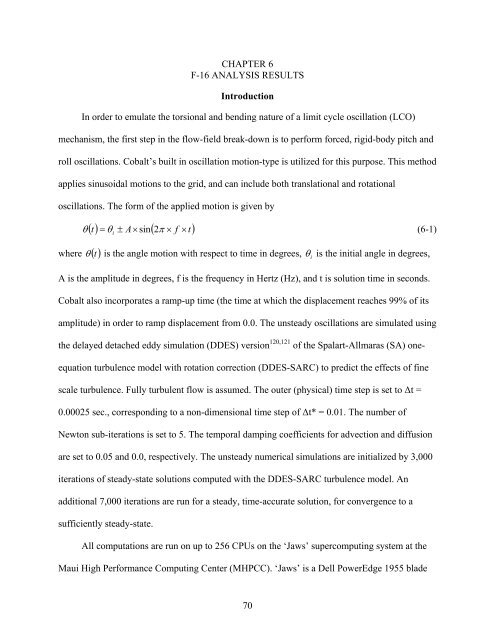university of florida thesis or dissertation formatting template
university of florida thesis or dissertation formatting template
university of florida thesis or dissertation formatting template
Create successful ePaper yourself
Turn your PDF publications into a flip-book with our unique Google optimized e-Paper software.
CHAPTER 6<br />
F-16 ANALYSIS RESULTS<br />
Introduction<br />
In <strong>or</strong>der to emulate the t<strong>or</strong>sional and bending nature <strong>of</strong> a limit cycle oscillation (LCO)<br />
mechanism, the first step in the flow-field break-down is to perf<strong>or</strong>m f<strong>or</strong>ced, rigid-body pitch and<br />
roll oscillations. Cobalt’s built in oscillation motion-type is utilized f<strong>or</strong> this purpose. This method<br />
applies sinusoidal motions to the grid, and can include both translational and rotational<br />
oscillations. The f<strong>or</strong>m <strong>of</strong> the applied motion is given by<br />
() t = θ i ± A×<br />
( π × f × t)<br />
θ sin 2<br />
(6-1)<br />
where θ () t is the angle motion with respect to time in degrees, θ i is the initial angle in degrees,<br />
A is the amplitude in degrees, f is the frequency in Hertz (Hz), and t is solution time in seconds.<br />
Cobalt also inc<strong>or</strong>p<strong>or</strong>ates a ramp-up time (the time at which the displacement reaches 99% <strong>of</strong> its<br />
amplitude) in <strong>or</strong>der to ramp displacement from 0.0. The unsteady oscillations are simulated using<br />
the delayed detached eddy simulation (DDES) version 120,121 <strong>of</strong> the Spalart-Allmaras (SA) one-<br />
equation turbulence model with rotation c<strong>or</strong>rection (DDES-SARC) to predict the effects <strong>of</strong> fine<br />
scale turbulence. Fully turbulent flow is assumed. The outer (physical) time step is set to Δt =<br />
0.00025 sec., c<strong>or</strong>responding to a non-dimensional time step <strong>of</strong> Δt* = 0.01. The number <strong>of</strong><br />
Newton sub-iterations is set to 5. The temp<strong>or</strong>al damping coefficients f<strong>or</strong> advection and diffusion<br />
are set to 0.05 and 0.0, respectively. The unsteady numerical simulations are initialized by 3,000<br />
iterations <strong>of</strong> steady-state solutions computed with the DDES-SARC turbulence model. An<br />
additional 7,000 iterations are run f<strong>or</strong> a steady, time-accurate solution, f<strong>or</strong> convergence to a<br />
sufficiently steady-state.<br />
All computations are run on up to 256 CPUs on the ‘Jaws’ supercomputing system at the<br />
Maui High Perf<strong>or</strong>mance Computing Center (MHPCC). ‘Jaws’ is a Dell PowerEdge 1955 blade<br />
70
















